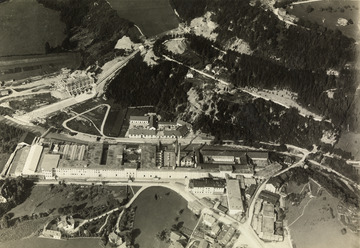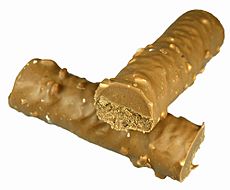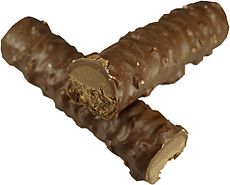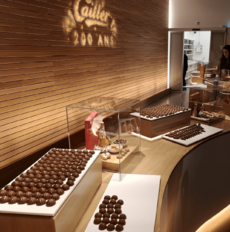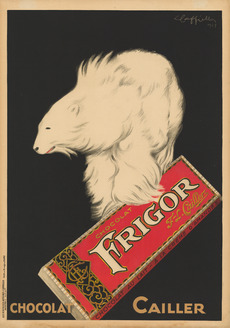Cailler facts for kids
Cailler is a famous Swiss chocolate brand and factory located in Broc, Switzerland. It was started by François-Louis Cailler in 1819 in Vevey. This makes Cailler the oldest chocolate brand still around in Switzerland!
For many years, Cailler was an independent company. But in 1929, a big food company called Nestlé bought Cailler, and it became one of their popular chocolate brands.
 |
|

The historical building of the Cailler chocolate factory in Broc. It also hosts the visitors' centre "Maison Cailler"
|
|
|
Formerly
|
|
|---|---|
| Private (1819–1929) | |
| Industry | Food |
| Fate | Purchased by Nestlé in 1929, became a brand |
| Founded | 1819 in Corsier-sur-Vevey |
| Founder | François-Louis Cailler, Peter Cailler Kohler (PCK) |
| Headquarters | , |
| Products | Confectionery, Swiss chocolate |
| Brands | Chocolat Kohler, Peter's Chocolate |
| Owner | Nestlé |
Contents
History of Cailler Chocolate
Early Days in Vevey
François-Louis Cailler was born in Vevey, Switzerland, in 1796. In 1818, he opened a grocery store where he also sold chocolate. Back then, people often thought of chocolate as a medicine or a health drink, not just a tasty treat. They usually mixed it with water or milk.
In 1819, Cailler opened his first chocolate factory in a nearby town called Corsier-sur-Vevey. This was one of the first modern chocolate factories ever! It helped Cailler make solid, affordable chocolate that could be shaped into bars or blocks. His business did very well. After a few years, he offered 16 different types of chocolate, each with its own special wrapper. Some popular kinds were pur caraque and commun sucré, which were even sold outside Switzerland. Cailler also made chocolate bars flavored with vanilla and cinnamon.
To make even more chocolate, Cailler opened two more factories in 1832 and 1840. These factories used water power from a nearby canal. François-Louis Cailler passed away in 1852. His wife, Louise-Albertine, and their sons, Auguste and Alexandre, continued to run the company.
In 1861, one of Cailler's factories was sold to his son-in-law, Daniel Peter. Peter later started his own chocolate company there. After many years, he invented milk chocolate!
In the early 1890s, Cailler started making a new kind of chocolate that was perfect for eating. This was thanks to a special process called conching, which makes chocolate super smooth.
The Broc Factory Era
In 1898, Alexandre-Louis Cailler, who was François-Louis Cailler's grandson, opened the current Cailler factory in Broc. The next year, a special power plant was built on the Jogne river. This plant used the river's water to create electricity for the whole village of Broc.
In 1912, a railway line was opened that connected the factory to Bulle, a bigger town nearby. This made it much easier to transport chocolate. The Broc factory began making huge amounts of chocolate, especially milk chocolate, using fresh milk from local farms. A foreman who used to work for Daniel Peter helped Cailler create this new milk chocolate, which became very popular.
The number of workers at the factory grew quickly. In 1898, there were 76 workers, but by 1901, there were 630! The number of workers reached its highest point in 1930, with 1,796 people working there.
Meanwhile, in 1904, Daniel Peter teamed up with Charles-Amédée Kohler, whose father had started Chocolat Kohler in 1830. They formed a new company. In 1911, this company joined with Cailler. Finally, in 1929, the combined company merged with the Nestlé group. For a while, Nestlé used all three names – Peter, Cailler, and Kohler – for its chocolates. But eventually, Nestlé decided to keep only the Cailler brand for the chocolate made in Broc.
In 2006, Cailler changed its packaging. New clear plastic boxes were designed by a famous architect named Jean Nouvel. However, some people didn't like the new packaging, and prices also went up. This led to some stores refusing to sell Cailler products. So, in 2007, the plastic packaging was stopped.
Cailler Factory Location
The Cailler factory is located in the Fribourg region of Switzerland. This area is known for its beautiful Gruyères region and its excellent milk, which is perfect for making delicious chocolate. The chocolates are made at a place called Maison Cailler.
The factory is just north of Broc, right by the Jogne river, where it flows into the Lake of Gruyère. The factory even has its own train station, Broc-Fabrique. This station connects to Bulle by a railway line that was updated in 2023.
Visiting Maison Cailler
Maison Cailler is a fun place to visit! It teaches visitors about the history of the Cailler brand. You can also learn where the ingredients come from and how chocolate is made. The best part is the tasting room, where you get to try different chocolates at the end of your tour!
The factory is open every day of the week. Tours are available in 12 different languages. Besides the museum, you can also take chocolate-making workshops, play an escape game, or enjoy the outdoor playground.
There's even a special "Chocolate Train" that takes visitors from Montreux directly to the factory.
Cailler Chocolate Products
Cailler makes many different kinds of chocolate bars, usually in 100g and 200g sizes. They have milk chocolate, dark chocolate, and white chocolate. They also make individual chocolate bars, like the famous Branche.
Cailler also produces boxes of pralines, which are small, fancy chocolates. The oldest praline boxes are Ambassador (made since 1890) and Fémina (made since 1902). Some Cailler products, especially the Branche, are so popular that other chocolate makers try to copy them.
Here are some of Cailler's most well-known products:
- Ambassador (since 1890): A box filled with different kinds of pralines.
- Crémant (1890s): A dark chocolate bar.
- Lait (1898): A plain milk chocolate bar made with special condensed milk. It comes in a purple wrapper.
- Fémina (1902): Another box of assorted pralines, similar to gianduja (a creamy chocolate-hazelnut spread).
- Branche (1904): This is a very famous chocolate bar! It's shaped like a rugged cylinder, kind of like a tree branch. The original Branche has a creamy praline center, covered in milk chocolate and hazelnut pieces. It comes in red, blue, or green wrappers. The Branche was first created by Kohler, but Cailler has been making it since 1904. It was originally made by melting down broken chocolates and shaping them into sticks by hand. People often put a Branche inside a bread roll or bun. The name branche has even become a general word in French for any chocolate bar shaped like it. Cailler also makes other flavors, like a dark chocolate version.
- Chocmel (1920): A milk chocolate bar with honey and almonds. It might have been inspired by Toblerone.
- Frigor (1923): A milk chocolate bar with a soft hazelnut and almond cream filling.
- Rayon (1937): A milk chocolate bar with honey nougat and air bubbles.
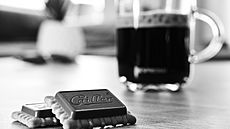
Kambly Cailler chocolate biscuits
|
Other Chocolates
Other chocolate bars have also been made by Nestlé at the Cailler factory. One example is the Chokito bar, which has been made since 1964. In 2018, the production of Chokito (and Rayon) moved to other factories in Switzerland.
Images for kids
See also
 In Spanish: Cailler para niños
In Spanish: Cailler para niños


